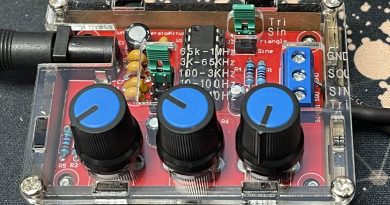Ten Measurements Using an Oscilloscope
1) Measuring and Viewing Voltage Waveforms
You can measure and view either DC or AC signals up to the oscilloscope’s BW using the standard voltage vs time mode of operation. Adjust the vertical setting to display the complete waveform and determine the value by counting the vertical divisions and multiplying by the vertical scale factor. Most digital storage oscilloscopes have a measurement menu that directly displays values without forcing you to count graticules.
2) Measuring and Viewing Current Waveforms
You may view current values and waveforms using an external low-value shunt resistor. Use Ohm’s law* to determine the correct scale multiplier for the measurement. The current shunt should be connected to the “low” side of the power.
*I = E / R
3) Measuring Frequency
You can perform frequency measurements by displaying the signal waveform on the oscilloscope’s screen and adjusting the horizontal time base value until you see at least one full cycle on the display. Measure the time value for one cycle and determine the frequency using the equation Freq = 1 / time.
4) Measuring Rise Time of a Pulse
You can determine the rise time of a pulse signal in a manner similar to frequency. Adjust the horizontal time base to display the rising edge of the pulse. Rise time is defined as the time between 10% and 90% of the amplitude.
5) Measuring Capacitance
You can estimate capacitance using a simple RC circuit and noting the phase difference between applied and resultant voltage across the capacitor using both vertical channels of the oscilloscope. The phase difference is noted and the capacitance is calculated using the following formula (α is the phase angle and Z is the impedance):
Capacitance = -1 / (2 x π x frequency x Z x sin(α))
6) Measuring Amplifier Gain
You may measure the gain or amplification of a circuit using both channel one and channel two of the oscilloscope. You will monitor the input signal with one channel and the output signal with the other. The difference between the amplitudes of these two signals indicates the gain.
7) Measuring Cable Length (TDR)
You may use a simple Time Domain Reflectometer (TDR) to determine the approximate length of a cable. A single fast-rising pulse from a pulse generator is simultaneously applied to the cable and the oscilloscope’s vertical channel. The time required for the pulse to travel to the end of the cable and reflect back again is a factor of both the cable length and the cable’s dielectric constant. The formula for measuring cable length is:
Length = (velocity of propagation x time) / 2
8) Measuring Differential Signals
You can measure differential signals, such as on a twisted pair cable, by using both of the oscilloscope’s vertical channels simultaneously. Use the MATH operation CH1-CH2 if both vertical channels are set to the same scale factor.
9) Measuring Signal Spectrum (FFT)
You can use the MATH operation FFT to view a waveform in an amplitude vs frequency representation. This is a simplified spectrum analyzer-type measurement and is useful for determining the frequency components of a periodic signal.
10) Measuring Duty-Cycle of a PWM Signal
You can determine the duty cycle of a PWM signal by displaying one complete cycle on the oscilloscope’s screen, which will enable you to determine the width of the positive portion as well as the width of the negative portion. Then you calculate the duty cycle with the following formula:
Duty cycle = (pulse high / (pulse high + pulse low) x 100%
